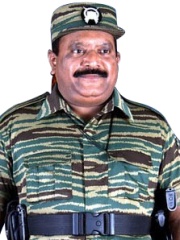
The Most Famous
MAFIOSOS from Sri Lanka
Top 1
The following people are considered by Pantheon to be the most legendary Sri Lankan Mafiosos of all time. This list of famous Sri Lankan Mafiosos is sorted by HPI (Historical Popularity Index), a metric that aggregates information on a biography's online popularity.

1. Velupillai Prabhakaran (1954 - 2009)
With an HPI of 69.46, Velupillai Prabhakaran is the most famous Sri Lankan Mafioso. His biography has been translated into 43 different languages on wikipedia.
Velupillai Prabhakaran (26 November 1954 – 18 May 2009) was a Sri Lankan guerrilla and a major figure of Tamil nationalism, being the founder and leader of the Liberation Tigers of Tamil Eelam (LTTE). The LTTE was a militant organization that sought to create an independent Tamil state in the north and east of Sri Lanka in reaction to the oppression of the country's Tamil population by the Sri Lankan government. Under his direction, the LTTE undertook a military campaign against the Sri Lankan government for more than 25 years. Prabhakaran was the youngest of four children, born in Valvettithurai, on Sri Lanka's Jaffna peninsula's northern coast. Considered the heart of Tamil culture and literature in Sri Lanka, Jaffna was concentrated with growing Tamil nationalism, which called for autonomy for Tamils to protest the discrimination against them by the Sinhalese-dominated Sri Lankan state and Sinhalese civilians since the country's independence from the United Kingdom in 1948. Founded in 1976, after the 1974 Tamil conference killings by Sri Lankan government police, the LTTE came to prominence in 1983 after it ambushed a patrol of the Sri Lanka Army outside Jaffna, resulting in the deaths of 13 soldiers. This ambush, along with the subsequent pogrom that resulted in the deaths of thousands of Tamil civilians, is generally considered the start of the Sri Lankan Civil War. After years of fighting, including the intervention of the Indian Army (IPKF), the conflict was halted after international mediation in 2001. By then, the LTTE, which came to be known as the Tamil Tigers, controlled large swathes of land in the north and east of the country, running a de facto state with Prabhakaran as its leader. Peace talks eventually broke down, and the Sri Lanka Army launched a military campaign to defeat the LTTE in 2006. Prabhakaran, who had said, "I would prefer to die in honour rather than being caught alive by the enemy", was killed in a firefight with the Sri Lankan Army in May 2009. Charles Anthony, his eldest son, was also killed. Additionally, the bodies of his wife and daughter were reportedly found by the Sri Lankan army; the Sri Lankan government later denied the report. His 12-year-old second son was executed a short time later. Prabhakaran's reported death and the subsequent ceasefire announcement by Selvarasa Pathmanathan, the Tigers' chief of international relations, brought an end to the armed conflict. A significant figure of Sri Lankan Tamil nationalism, Prabhakaran is often seen as a martyr by Sri Lankan Tamils. However, he is acknowledged to have created one of the most ruthless and sophisticated insurgencies of the modern era, with many of the tactics he pioneered influencing political militant groups globally. Prabhakaran himself argued that he chose military means only after observing that nonviolent means were ineffectual and obsolete, especially after the Tamil Eelam revolutionary Thileepan's fatal hunger strike in 1987 had no effect. Influenced by Indian nationalists Subhas Chandra Bose and Bhagat Singh, both of whom participated in the revolutionary movement for Indian independence, Prabhakaran declared that his goal was 'revolutionary socialism and the creation of an egalitarian society'.
People
Pantheon has 1 people classified as Sri Lankan mafiosos born between 1954 and 1954. Of these 1, none of them are still alive today. The most famous deceased Sri Lankan mafiosos include Velupillai Prabhakaran.

